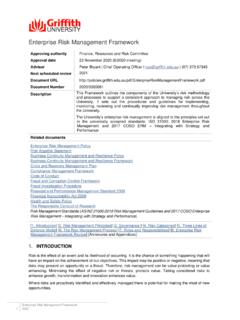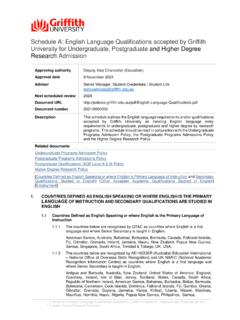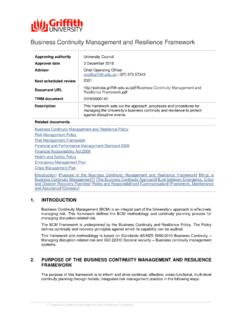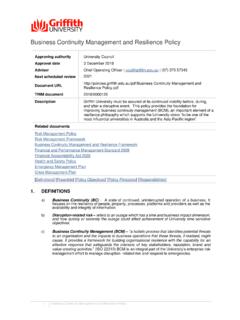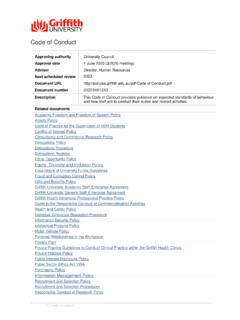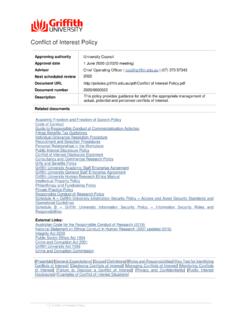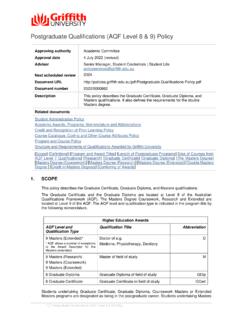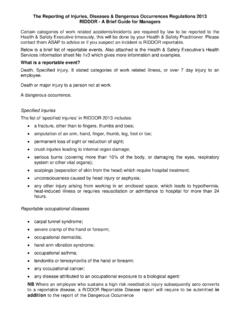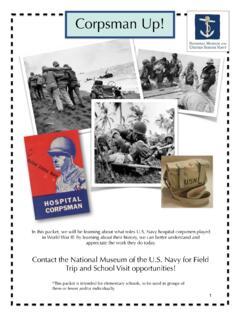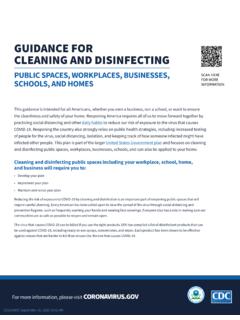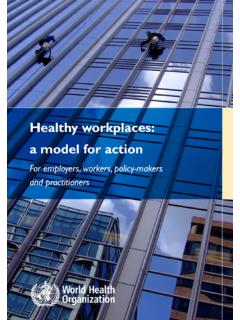Transcription of Reporting and recording procedures for incidents, injuries ...
1 1 Reporting and recording procedures for incidents, injuries , illness, hazards or near misses Reporting and recording procedures for incidents, injuries , illness, hazards or near misses Approving authority Vice President (Corporate Services) Approval date 11 February 2017 Advisor Director, Health, Safety and Wellbeing | People & Wellbeing | | (07) 373 57802 Next scheduled review 2020 Document URL and recording procedures for incidents, injuries , illness, hazards or near TRIM document 2019/0000045 Description These procedures set out the requirements for Reporting , recording and notifying workplace injuries , work-caused illnesses, hazards and near misses. Related documents First Aid Guidelines Health and Safety Policy Electrical Safety Policy Electrical Safety Procedure Electrical Safety Procedure Test and Tag Guidelines for the Prevention and Control of Communicable and Notifiable Diseases Workplace Rehabilitation procedures Workers Compensation procedures External Links: Work Health and Safety Act 2011 Work Health and Safety Regulation 2011 Electrical Safety Act 2002 Electrical Safety Regulation 2013 Gene Technology Act 2000 Radiation Safety Act 1999 Radiation Safety Regulation 2010 Environment Protection and Biodiversity Conservation Act 1999 Radiation Queensland Office of the Gene Technology Regulator Department of Agriculture and Water Resources Queensland Health [Introduction] [Purpose and Objectives] [Scope] [Definitions and Terms] [ procedures ] [Delegated Authorities] [Flowchart for Reporting ] 1.
2 INTRODUCTION The University has a legal obligation under both State and Federal jurisdictions to report various events that may result in injury or illness of people who conduct business for, or on behalf of, the University. Primarily in Queensland, the Work Health and Safety Act 2011 requires a record to be kept of all work-related injuries , illnesses and dangerous incidents which arise from its activities and to eliminate or 2 Reporting and recording procedures for incidents, injuries , illness, hazards or near misses otherwise control hazards and risks within the workplace. In addition, the University must notify Workplace Health and Safety Queensland (the Regulator) of any death, serious injury or illness, dangerous incident, serious electrical event or serious electrical incident. The other legislative requirements are predominately in relation to diseases or illnesses that could be contracted or may develop out of work the University undertakes.
3 These are with Queensland Health, Radiation Queensland, the Office of the Gene Technology Regulator and the Department of Agriculture and Water Resources. 2. PURPOSE AND OBJECTIVES This procedure specifically outlines the Reporting protocols of all work-caused incidents, illnesses, injuries , hazards and near misses and non-work related injuries / illnesses for rehabilitation purposes. 3. SCOPE This procedure applies to all staff, unpaid appointments, students, contractors, volunteers, contractors and visitors that are involved in an incident, dangerous incidents; sustain an injury or illness; are exposed to hazards; and/or are subjected to a near miss whilst undertaking activities at/for the University. 4. DEFINITIONS AND TERMS GSafe is Griffith University s cloud based on-line incident, injury, hazard and near miss Reporting system.
4 This system has been developed specifically for the University s use, and provides a standardised electronic Reporting tool, and can be accessed via the Health and Safety intranet site. Near Miss is any unplanned incident that occurred at the workplace which, although not resulting in any injury or illness, had the potential to do so. Notifiable incidents incidents that are required to be reported to Workplace Health and Safety Queensland (WHSQ) that arise out of the conduct of a business or undertaking and results in the death, serious injury or serious illness of a person or involves a dangerous incident. These include: Serious injury or illness: o immediate treatment as an in-patient in a hospital (for any duration it does not include out-patient treatment provided by the emergency section of a hospital and immediate discharge or subsequent corrective surgery) o immediate treatment for: the amputation of any part of their body a serious head injury relates to an injury to the skull, such as a fractured skull, loss of consciousness, blood clot or bleeding in the brain, damage to the skull to the extent that it is likely to affect organ/face function.
5 A serious eye injury the injury that results in or is likely to result in the loss of the eye or total or partial loss of vision. Includes an object penetrating the eye or exposure of the eye to a substance which poses a risk of serious eye damage, It does not include exposure to a substance that merely causes eye irritation. a serious burn a burn that requires intensive care or critical care which could require a compression garment or skin graft. It does not include a burn that merely requires washing the wound, ice pack and applying a dressing. the separation of their skin from an underlying tissue (such as de-gloving or scalping) a spinal injury an injury to the cervical, thoracic, lumbar or sacral vertebrae, including the discs and spinal cord. 3 Reporting and recording procedures for incidents, injuries , illness, hazards or near misses the loss of a bodily function, loss of consciousness, loss of movement of a limb or loss of the sense of smell, taste, hearing or loss of function of an internal organ.
6 It does not include mere fainting or a sprain, strain or fracture. serious lacerations is a serious laceration that causes muscle, tendon, nerve or blood vessel damage or permanent impairment. It includes deep or extensive cuts and tears of wounds to the flesh or tissues (this includes stitching) or o medical treatment (treatment by a doctor) within 48 hours of exposure to a substance o any infection to which the carrying out of work is a significant contributing factor, including any infection that is reliably attributable to carrying out work: with micro-organisms; or that involves providing treatment or care to a person; or that involves contact with human blood or body substances; or that involves handling or contact with animals, animal hides, skins, wool or hair, animal carcasses or animal waste products. o the following occupational zoonoses contracted in the course of work involving the handling or contact with animals, animal hides, skins, wool or hair, animal carcasses or animal waste products: Q fever Anthrax Leptospirosis Brucellosis Hendra virus Avian influenza Psittacosis.
7 dangerous incident is an incident in relation to a workplace that exposes a worker or any other person to a serious risk to a person's health or safety emanating from an immediate or imminent exposure to: o an uncontrolled escape, spillage or leakage of a substance; o an uncontrolled implosion, explosion or fire; o an uncontrolled escape of gas or steam; o an uncontrolled escape of a pressurised substance; o electric shock (not static electricity); o the fall or release from a height of any plant, substance or thing; o the collapse, overturning, failure or malfunction of, or damage to, any plant that is required to be authorised for use in accordance with the regulations; o the collapse or partial collapse of a structure; o the collapse or failure of an excavation or of any shoring supporting an excavation; o the inrush of water, mud or gas in workings, in an underground excavation or tunnel; or o the interruption of the main system of ventilation in an underground excavation or tunnel.
8 Serious electrical incident is where a person: o is killed by electricity; o receives a shock or injury from electricity, and is treated for the shock or injury by or under the supervision of a doctor; or o receives a shock or injury from electricity at high voltage (voltage above 1000 V AC or 1500 V ripple-free DC), whether or not the person is treated for the shock or injury by or under the supervision of a doctor. dangerous electrical event includes: o when a person, for any reason, is electrically unsafe around high voltage electrical equipment, even if the person doesn t receive an electric shock or injury; o significant property damage caused by electricity or something originating from electricity electrical fire; o unlicensed electrical work; 4 Reporting and recording procedures for incidents, injuries , illness, hazards or near misses o unsafe electrical work; or Unsafe electrical equipment or electrical equipment that does not have Electrical Equipment Safety System (EESS) approval markings.
9 Other Notifiable and communicable diseases are defined for each of the following Government Departments on line Queensland Health Communicable Disease Unit / Public Health Unit Office of the Gene Technology Regulator (OGTR) Office of the Department of Agriculture and Water Resources Worker - if the person carries out work in any capacity for a person conducting a business or undertaking, including work as an employee, a contractor (or subcontractor), an employee of a labour hire company, an outworker, an apprentice or trainee, a student gaining work experience or a volunteer. Workplace is a place where work is carried out for a business or undertaking and includes any place where a worker goes, or is likely to be, while at work. For the purposes of this procedure this includes research and study activities undertaken for or on behalf of the University either on or off campus (includes undertaking study or research, work experience or community placement as part of their studies).
10 Workplace Health and Safety Queensland (WHSQ) the regulator for all workplaces and work caused injury and illnesses. 5. procedures To comply with legislative requirements and to proactively interrogate our incidents and illness data to reduce the instances of harm, the University is committed to: prompt Reporting of all incidents involving staff, students, contractors, volunteers and visitors, and investigate them as required via GSafe; recording and Reporting of incidents in accordance with the Work Health and Safety Act 2011 and associated Regulation; prompt action by supervisors to initiate action to prevent recurrence; and monitoring and reviewing incident statistics by University health and safety committees. Reporting and recording Incidents: WHSQ (Refer to Flow Chart Appendix 1) All workplace incidents, injuries , illnesses and near misses must be recorded as soon as possible but no more than within two days of occurring; however notifiable incidents must be reported immediately after becoming aware of the notifiable incident.
